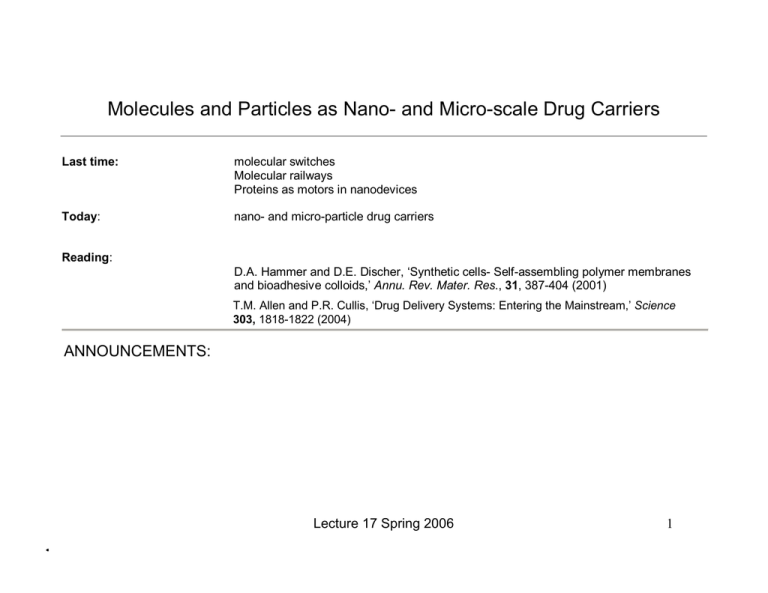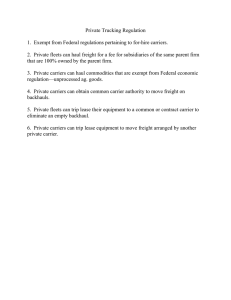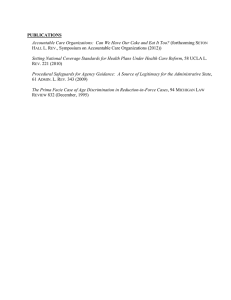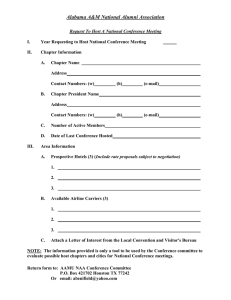Molecules and Particles as Nano- and Micro-scale Drug Carriers
advertisement

Molecules and Particles as Nano- and Micro-scale Drug Carriers Last time: molecular switches Molecular railways Proteins as motors in nanodevices Today: nano- and micro-particle drug carriers Reading: D.A. Hammer and D.E. Discher, ‘Synthetic cells- Self-assembling polymer membranes and bioadhesive colloids,’ Annu. Rev. Mater. Res., 31, 387-404 (2001) T.M. Allen and P.R. Cullis, ‘Drug Delivery Systems: Entering the Mainstream,’ Science 303, 1818-1822 (2004) ANNOUNCEMENTS: Lecture 17 Spring 2006 1 Carriers Nanoparticles Image removed due to copyright reasons. Please see: Kakizawa, Y., and K. Kataoka. "Block Copolymer Micelles for Delivery of Gene and related compounds." Adv Vesicles Drug Deliv Rev 54 (2002): 203-22. Polymer-durg conjugates Micelles Liposomes PLGA Polymerosomes 10 nm Microparticles Biological Structures Proteins Viruses Plasma membrane Actin Fibers Packed chromosomes Protein Complexes Thickness of lipid bilayer 1 nm 10 nm Organelles 100 nm 1000 nm Figure by MIT OCW. Lecture 17 Spring 2006 2 Objectives of molecular and particulate drug carriers: •• (I) Alter pharmacokinetics –– •• How long is the drug active, and at what concentration is it present? (II) Alter biodistribution –– Which tissues receive drug? • •• Enhance uptake at target tissue, reduce uptake where it is not desirable (III) Provide drug reservoirs –– Fewer injections, sustained level of therapeutic Table removed due to copyright reasons. Please see: Table 1 in Allen, and Cullis. Science 303 (2004): 1818. Lecture 17 Spring 2006 3 Applications of polymer-drug conjugates and particles as drug carriers and cellular markers: two general challenges (1) EXTRACELLULAR BARRIERS: Delivery of molecules to tissues from circulation, skin, or mucosal surfaces INTRAVENOUS ORAL Image removed due to copyright restrictions. Please see Neutra, M. R, and P. A. Kozlowski. "Mucosal Vaccines: The Promise and The Challenge." Nat Rev Immunol 6 (2006): 148. Lecture 17 Spring 2006 4 Applications of polymer-drug conjugates and particles as drug carriers and cellular markers: two general challenges SKIN NASAL/LUNG MUCOSA Images removed due to copyright restrictions. Please see Neutra, M. R., and P. A. Kozlowski. "Mucosal Vaccines: The Promise and The Challenge." Nat Rev Immunol 6 (2006): 148. Lecture 17 Spring 2006 5 Applications of polymer-drug conjugates and particles as drug carriers and cellular markers: two general challenges (2) INTRACELLULAR BARRIERS: Intracellular drug delivery B C A Lecture 17 Spring 2006 6 Applications of polymer-drug conjugates and particles as drug carriers and cellular markers: two general challenges (2) INTRACELLULAR BARRIERS: Intracellular drug delivery Applications requiring delivery of molecules to intracellular compartments: Vaccines MHC restriction of T cell Gene delivery Plasmid DNA for expression of missing/foreign genes Anti-sense therapy, siRNA/RNAi Therapeutic molecules Intracellular toxins (e.g. toxins that bind DNA to block transcription/cell division) Drug delivery to mitochondria (affect metabolism) CYTOSOL NUCLEUS Image removed for copyright reasons. Please see: http://www.cbs.dtu.dk/staff/dave/ roanoke/mitochon.gif MITOCHONDRIA Lecture 17 Spring 2006 7 Objectives of nano- and micro-carriers: (1) protection of cargos from premature degradation COMPOUND APPLICATION EXAMPLE HALF-LIV ES IN CIRCULATION Short peptides (5-20 amino acids) Vaccine epitopes, ligands for drug targeting, peptide drugs 2 min., 5 min, 2 hrs Cytokines (polypeptides typically 5-20 KDa) Regulation of tissue physiology (e.g., growth factors), disease treatment (e.g., interferon-α) IFN-α 3-8 hrs interleukin-6 2.1 min tumor necrosis factor 3 min EXTRACELLULAR CLEARANCE: REFERENCES J. Biol. Chem. 48, 48503 (2002); J. Pharm. Sci. 81, 731 (1992) Nat Rev Drug Discov 2, 214-21 (2003) INTRACELLULAR CLEARANCE: Protection of DNA from DNAses Abbott laboratories anti-TNF antibody for treatment of Rheumatoid arthritis: 40 mg every 2 weeks… (active at nM conc.) Lecture 17 Spring 2006 8 Objectives of nano- and micro-carriers: (2) Avoiding the immune system (I) Opsonization: Images removed due to copyright reasons. Please see: http://medtech.cls.msu.edu/ISL/immunology/opsonize.htm Internalization is also triggered by complement Protein adsorption can trigger opsonization (via exposure of un-natural epitopes) (II) anti-drug/carrier antibody production: •B cells binding to a foreign protein, drug, or particle can be triggered to produce antibodies against the drug or carrier •Even human proteins provided in non-physiological contexts may elicit antibodies (e.g., DNA) Image removed due to copyright reasons. Please see: Abbas, A. K., and A. H. Lichtman. Cellular and Molecular Immunology. San Diego, CA: Elsevier, 2005. ISBN: 1416023895. Lecture 17 Spring 2006 9 Objectives of nano- and micro-carriers: (3) targeted delivery to select tissues or cells Sketch ligand-mediated binding and uptake on cells Lecture 17 Spring 2006 10 OVERVIEW OF MOLECULAR/PARTICULATE DRUG CARRIERS: STRUCTURE, SYNTHESIS, PROPERTIES Carriers Nanoparticles Image removed due to copyright reasons. Please see: Kakizawa, Y., and K. Kataoka. "Block Copolymer Micelles for Delivery of Gene and related compounds." Adv Vesicles Drug Deliv Rev 54 (2002): 203-22. Polymer-durg conjugates Micelles Liposomes PLGA Polymerosomes 10 nm Microparticles 2-10 nm 1 nm 5-50 nm 10 nm 50-2,000 nm 100 nm 50-10,000 nm 1000 nm Figure by MIT OCW. Lecture 17 Spring 2006 11 Polymer pro-drugs and markers Role of polymeric carriers: 1. 2. Control solubility of drug Multivalency • • High avidity binding to low-affinity receptors for detection/delivery Cooperative binding – 2nd/3rd, … binding event is facilitated by initial ligation Potent delivery on a per-molecule basis 3. Aid penetration of tissues 4. ‘stealth’ functions Lecture 17 Spring 2006 12 Polymer pro-drugs and markers Architecture of polymeric carriers: SKETCH FROM ADV MATER 1995 REVIEW 1. Requires water-soluble backbone e.g., PEG, dextran, PHEMA 2. Drug may need to be selectively released nonspecific- hydrolysis of side chains triggered release- localized to specific microenvironment pH enzyme recognition Lecture 17 Spring 2006 13 Polymer pro-drugs and markers Endosomal enzyme-sensitive marker: Fluorochromes quenched until enzyme clips backbone Image removed due to copyright restrictions. Image removed due to copyright reasons. Please see: Weissleder, et al. Nat Biotech 17, 375 (1999). Pro-Ile-Cys(Et)-Phe-Phe-Arg-Leu cathepsin D substrate Lecture 17 Spring 2006 14 Polymer pro-drugs and markers Cell-activated polymer-fluorochrome conjugates for in vivo tumor imaging: Sketch leaky tumor vasculature, conjugate uptake concept Images removed due to copyright reasons. Please see: Weissleder, et al. Nat Biotech 17, 375 (1999). Lecture 17 Spring 2006 15 Micelle carriers Cargo-loaded micelles via polyion association: Figure removed due to copyright reasons. Please see: Figure 5 in Kakizawa, Y., and K. Kataoka. "Block Copolymer Micelles for Delivery of Gene and Related Compounds." Adv Drug Deliv Rev 54 (2002): 203-22. Images removed due to copright reasons. Please see: Kakizawa, Y., and K. Kataoka. "Block Copolymer Micelles for Delivery of Gene and Related Compounds." Adv Drug Deliv Rev 54 (2002): 203-22. Lecture 17 Spring 2006 16 Micelle drug carriers Attachment of cargo molecules to core block of micelle: Figure removed due to copyright restrictions. Figure removed due to copyright restrictions. Limitations: Unstable at high dilution Low cargo capacity Lecture 17 Spring 2006 17 Further Reading 1. 2. 3. 4. 5. 6. 7. 8. 9. 10. 11. 12. Torchilin, V. P. PEG-based micelles as carriers of contrast agents for different imaging modalities. Advanced Drug Delivery Reviews 54, 235-252 (2002). Weissig, V. & Torchilin, V. P. Drug and DNA delivery to mitochondria. Adv Drug Deliv Rev 49, 1-2 (2001). Kakizawa, Y. & Kataoka, K. Block copolymer micelles for delivery of gene and related compounds. Adv Drug Deliv Rev 54, 203-22 (2002). Torchilin, V. P. PEG-based micelles as carriers of contrast agents for different imaging modalities. Adv Drug Deliv Rev 54, 235-52 (2002). Harris, J. M. & Chess, R. B. Effect of pegylation on pharmaceuticals. Nat Rev Drug Discov 2, 214-21 (2003). Park, S. & Healy, K. E. Nanoparticulate DNA packaging using terpolymers of poly(lysineg-(lactide-b-ethylene glycol)). Bioconjug Chem 14, 311-9 (2003). Moghimi, S. M., Hunter, A. C. & Murray, J. C. Long-circulating and target-specific nanoparticles: theory to practice. Pharmacol Rev 53, 283-318 (2001). Li, Y. et al. PEGylated PLGA nanoparticles as protein carriers: synthesis, preparation and biodistribution in rats. J Control Release 71, 203-11 (2001). Stolnik, S., Illum, L. & Davis, S. S. Long Circulating Microparticulate Drug Carriers. Advanced Drug Delivery Reviews 16, 195-214 (1995). Kozlowski, A. & Harris, J. M. Improvements in protein PEGylation: pegylated interferons for treatment of hepatitis C. J Control Release 72, 217-24 (2001). Efremova, N. V., Bondurant, B., O'Brien, D. F. & Leckband, D. E. Measurements of interbilayer forces and protein adsorption on uncharged lipid bilayers displaying poly(ethylene glycol) chains. Biochemistry 39, 3441-51 (2000). Halperin, A. Polymer brushes that resist adsorption of model proteins: Design parameters. Langmuir 15, 2525-2533 (1999). Lecture 17 Spring 2006 35





